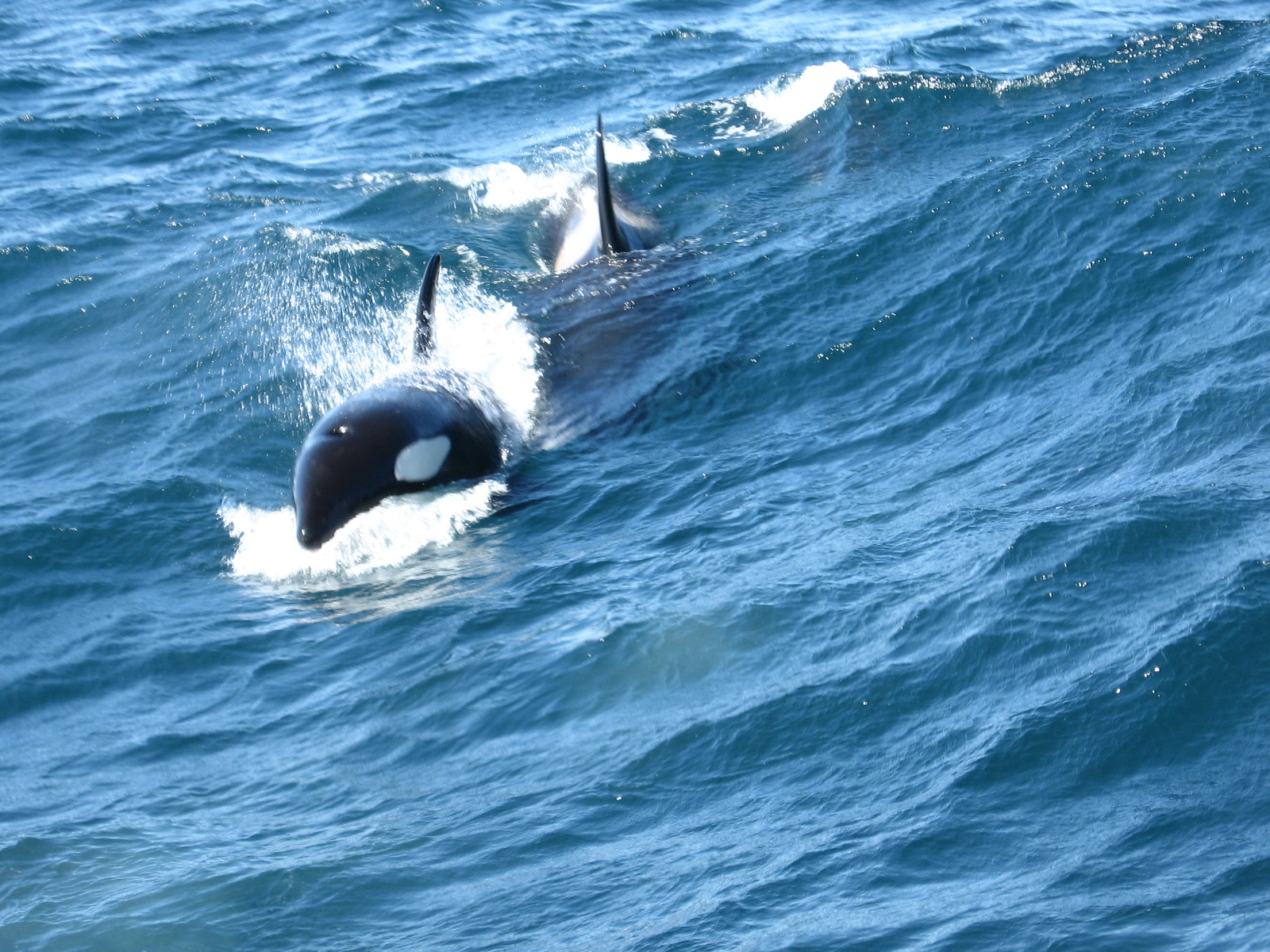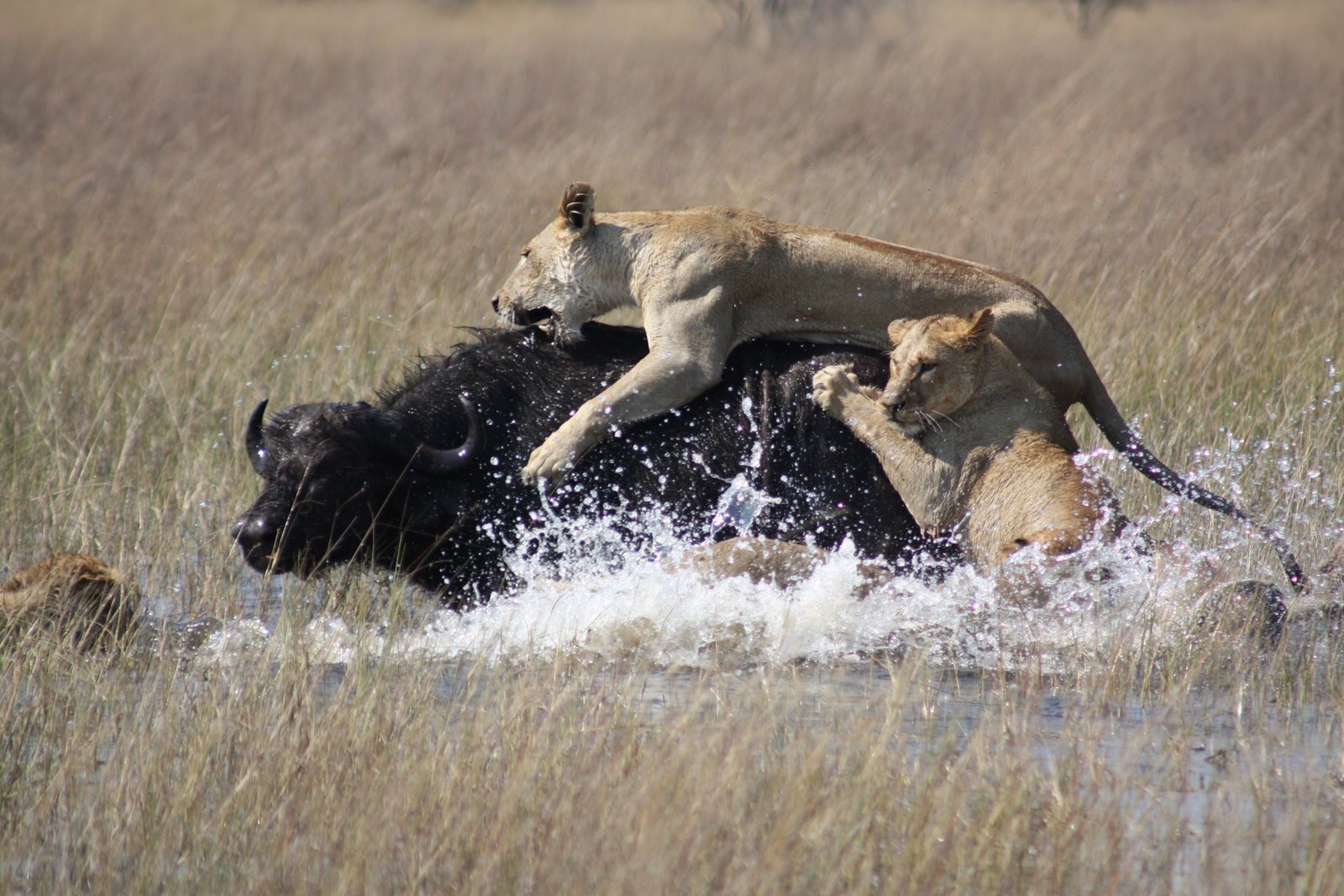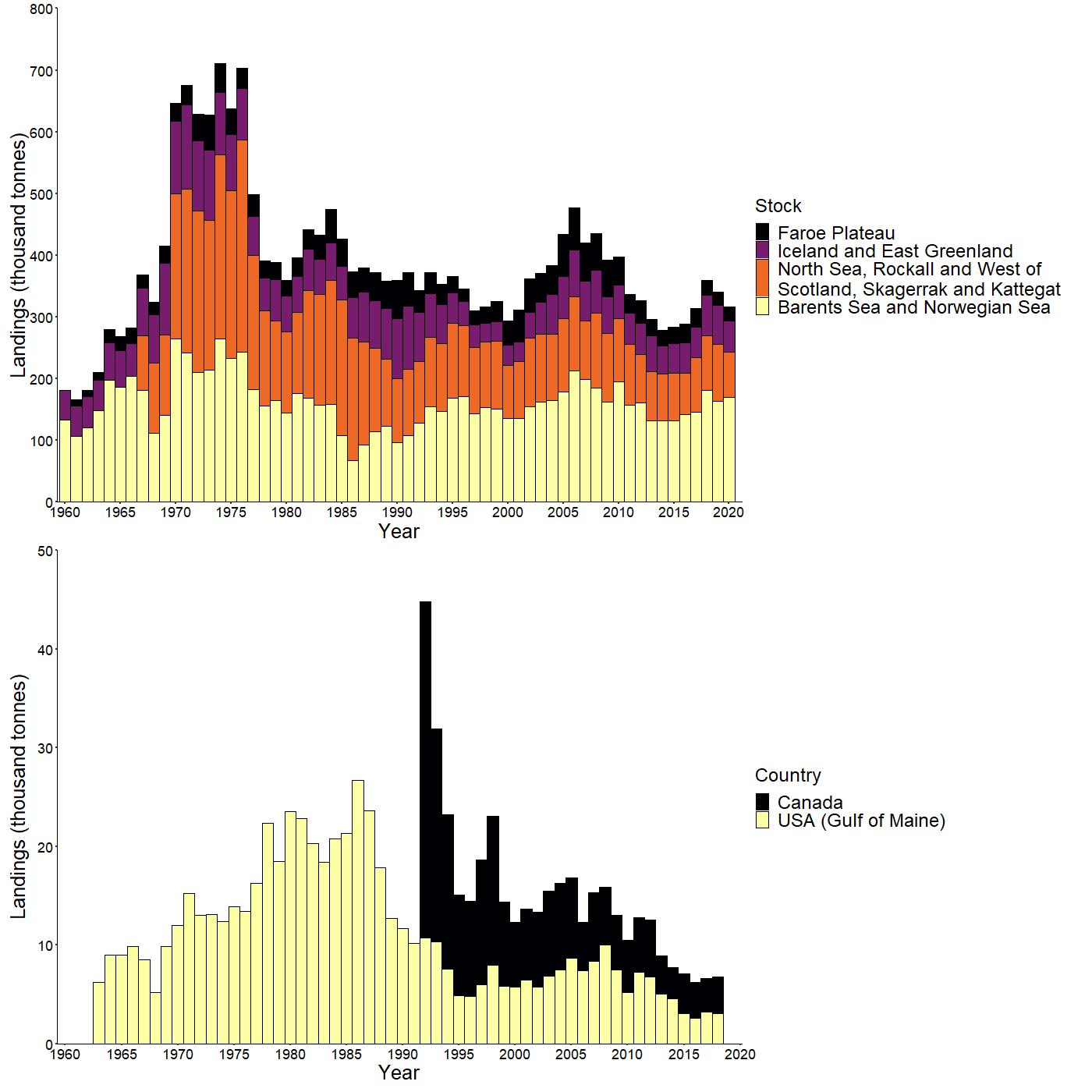|
Carousel Feeding
Carousel feeding is a cooperative hunting method used by Norwegian orcas ( ''Orcinus orca'') to capture wintering Norwegian spring-spawning herring (''Clupea harengus)''. The term carousel feeding was first used to describe a similar hunting behaviour in bottlenose dolphins ( ''Turslops truncatus'') in the Black Sea. There are two main phases of carousel feeding in orcas, the herding phase and the feeding phase. In the herding phase the orcas surround a school of herring and herd them into a tight ball. They tighten the ball by blowing bubbles, flashing their white underside and slapping their tails on the surface. They move the ball of herring toward the surface of the water before initiating the feeding phase. During the feeding phase several orcas begin to eat while the others continue herding the fish to maintain the ball. The feeding orcas whip their tails into the ball to stun and kill several herring at a time. The dead and stunned herring are then consumed and their heads and ... [...More Info...] [...Related Items...] OR: [Wikipedia] [Google] [Baidu] |
Cooperative Hunting
A pack hunter or social predator is a predatory animal which hunts its prey by working together with other members of its species. Normally animals hunting in this way are closely related, and with the exceptions of chimpanzees where only males normally hunt, all individuals in a family group contribute to hunting. When hunting cooperation is across two or more species, the broader term cooperative hunting is commonly used. A well known pack hunter is the gray wolf; humans too can be considered pack hunters. Other pack hunting mammals include chimpanzees, dolphins, lions, dwarf and banded mongooses and spotted hyenas. Avian social predators include the Harris's hawk, butcherbirds, three of four kookaburra species and many helmetshrikes. Other pack hunters include army ants, the goldsaddle goatfish and occasionally crocodiles. Pack hunting is typically associated with cooperative breeding and its concentration in the Afrotropical realm is a reflection of this.For a brief expla ... [...More Info...] [...Related Items...] OR: [Wikipedia] [Google] [Baidu] |
Killer Whale
The orca or killer whale (''Orcinus orca'') is a toothed whale belonging to the oceanic dolphin family, of which it is the largest member. It is the only extant species in the genus ''Orcinus'' and is recognizable by its black-and-white patterned body. A cosmopolitan species, orcas can be found in all of the world's oceans in a variety of marine environments, from Arctic and Antarctic regions to tropical seas. Orcas have a diverse diet, although individual populations often specialize in particular types of prey. Some feed exclusively on fish, while others hunt marine mammals such as seals and other species of dolphin. They have been known to attack baleen whale calves, and even adult whales. Orcas are apex predators, as they have no natural predators. They are highly social; some populations are composed of very stable matrilineal family groups (pods) which are the most stable of any animal species. Their sophisticated hunting techniques and vocal behaviours, which are o ... [...More Info...] [...Related Items...] OR: [Wikipedia] [Google] [Baidu] |
Atlantic Herring
Atlantic herring (''Clupea harengus'') is a herring in the family (biology), family Clupeidae. It is one of the most abundant fish species in the world. Atlantic herrings can be found on both sides of the Atlantic Ocean, congregating in large Shoaling and schooling, schools. They can grow up to in length and weigh up to . They feed on copepods, krill and small fish, while their natural predators are pinniped, seals, whales, cod and other larger fish. The Atlantic herring fishery has long been an important part of the economy of New England and the Canada, Canadian Atlantic provinces. This is because the fish congregate relatively near to the coast in massive schools, notably in the cold waters of the semi-enclosed Gulf of Maine and Gulf of Saint Lawrence, Gulf of St. Lawrence. North Atlantic herring schools have been measured up to in size, containing an estimated 4 billion fish. Description Atlantic herring have a wikt:fusiform, fusiform body. Gill rakers in their mouths fi ... [...More Info...] [...Related Items...] OR: [Wikipedia] [Google] [Baidu] |
Common Bottlenose Dolphin
The common bottlenose dolphin or Atlantic bottlenose dolphin (''Tursiops truncatus'') is a wide-ranging marine mammal of the family Delphinidae. The common bottlenose dolphin is a very familiar dolphin due to the wide exposure it gets in captivity in marine parks and dolphinariums, and in movies and television programs.Leatherwood, S., & Reeves, R. (1990). ''The Bottlenose Dolphin''. San Diego: Academic Press, Inc., It is the largest species of the beaked dolphins. It inhabits temperate and tropical oceans throughout the world, and is absent only from polar waters.Klinowska, M. (1991). ''Dolphins, Porpoises and Whales of the World: The IUCN Red Data Book''. Gland, Switzerland, U.K.: IUCN, While formerly known simply as the bottlenose dolphin, this term is now applied to the genus ''Tursiops'' as a whole. As considerable genetic variation has been described within this species, even between neighboring populations, many experts think additional species may be recognized. Taxon ... [...More Info...] [...Related Items...] OR: [Wikipedia] [Google] [Baidu] |
Black Sea
The Black Sea is a marginal mediterranean sea of the Atlantic Ocean lying between Europe and Asia, east of the Balkans, south of the East European Plain, west of the Caucasus, and north of Anatolia. It is bounded by Bulgaria, Georgia, Romania, Russia, Turkey, and Ukraine. The Black Sea is supplied by major rivers, principally the Danube, Dnieper, and Don. Consequently, while six countries have a coastline on the sea, its drainage basin includes parts of 24 countries in Europe. The Black Sea covers (not including the Sea of Azov), has a maximum depth of , and a volume of . Most of its coasts ascend rapidly. These rises are the Pontic Mountains to the south, bar the southwest-facing peninsulas, the Caucasus Mountains to the east, and the Crimean Mountains to the mid-north. In the west, the coast is generally small floodplains below foothills such as the Strandzha; Cape Emine, a dwindling of the east end of the Balkan Mountains; and the Dobruja Plateau considerably farth ... [...More Info...] [...Related Items...] OR: [Wikipedia] [Google] [Baidu] |
Animal Echolocation
Echolocation, also called bio sonar, is a biological sonar used by several animal species. Echolocating animals emit calls out to the environment and listen to the echoes of those calls that return from various objects near them. They use these echoes to locate and identify the objects. Echolocation is used for navigation, foraging, and hunting in various environments. Echolocating animals include some mammals (most notably Laurasiatheria) and a few birds, especially some bat species and odontocetes (toothed whales and dolphins), but also in simpler forms in other groups such as shrews, and two cave-dwelling bird groups, the so-called cave swiftlets in the genus ''Aerodramus'' (formerly ''Collocalia'') and the unrelated oilbird ''Steatornis caripensis''. Early research The term ''echolocation'' was coined in 1938 by the American zoologist Donald Griffin, who, with Robert Galambos, first demonstrated the phenomenon in bats. As Griffin described in his book, the 18th century I ... [...More Info...] [...Related Items...] OR: [Wikipedia] [Google] [Baidu] |
Predation
Predation is a biological interaction where one organism, the predator, kills and eats another organism, its prey. It is one of a family of common feeding behaviours that includes parasitism and micropredation (which usually do not kill the host) and parasitoidism (which always does, eventually). It is distinct from scavenging on dead prey, though many predators also scavenge; it overlaps with herbivory, as seed predators and destructive frugivores are predators. Predators may actively search for or pursue prey or wait for it, often concealed. When prey is detected, the predator assesses whether to attack it. This may involve ambush or pursuit predation, sometimes after stalking the prey. If the attack is successful, the predator kills the prey, removes any inedible parts like the shell or spines, and eats it. Predators are adapted and often highly specialized for hunting, with acute senses such as vision, hearing, or smell. Many predatory animals, both vertebrate and inv ... [...More Info...] [...Related Items...] OR: [Wikipedia] [Google] [Baidu] |
Carnivore
A carnivore , or meat-eater (Latin, ''caro'', genitive ''carnis'', meaning meat or "flesh" and ''vorare'' meaning "to devour"), is an animal or plant whose food and energy requirements derive from animal tissues (mainly muscle, fat and other soft tissues) whether through hunting or scavenging. Nomenclature Mammal order The technical term for mammals in the order Carnivora is ''carnivoran'', and they are so-named because most member species in the group have a carnivorous diet, but the similarity of the name of the order and the name of the diet causes confusion. Many but not all carnivorans are meat eaters; a few, such as the large and small cats (felidae) are ''obligate'' carnivores (see below). Other classes of carnivore are highly variable. The Ursids, for example: While the Arctic polar bear eats meat almost exclusively (more than 90% of its diet is meat), almost all other bear species are omnivorous, and one species, the giant panda, is nearly exclusively herbivorous. ... [...More Info...] [...Related Items...] OR: [Wikipedia] [Google] [Baidu] |
R/K Selection Theory
In ecology, ''r''/''K'' selection theory relates to the selection of combinations of traits in an organism that trade off between quantity and quality of offspring. The focus on either an increased quantity of offspring at the expense of individual parental investment of ''r''-strategists, or on a reduced quantity of offspring with a corresponding increased parental investment of ''K''-strategists, varies widely, seemingly to promote success in particular environments. The concepts of quantity or quality offspring are sometimes referred to as "cheap" or "expensive", a comment on the expendable nature of the offspring and parental commitment made. The stability of the environment can predict if many expendable offspring are made or if fewer offspring of higher quality would lead to higher reproductive success. An unstable environment would encourage the parent to make many offspring, because the likelihood of all (or the majority) of them surviving to adulthood is slim. In contrast ... [...More Info...] [...Related Items...] OR: [Wikipedia] [Google] [Baidu] |
Pollachius Virens
The saithe ( or ) (''Pollachius virens'') is a species of marine fish in the Pollock genus ''Pollachius''. Together with '' P. pollachius'', it is generally referred to in the United States as pollock. Other names include the Boston blue (separate from bluefish), coalfish/coley, and saithe in the UK, where the young fish are called podleys in Scotland and northern England. Description This species can be separated from ''P. pollachius'' by looking at the relative lengths of the upper and lower jaws. ''P. pollachius'' has a longer underslung lower jaw while ''P. virens'' has approximately equal upper and lower jaw lengths. This gives a very different profile to the head. In general, ''P. pollachius'' is a brown or golden colour with a dark back while ''P. virens'' is bright silver with a very dark green back. ''P. virens'' generally appears to have relatively smaller eyes. The lateral line of ''P. pollachius'' has a noticeable kink over the pectoral fins while that of ''P. viren ... [...More Info...] [...Related Items...] OR: [Wikipedia] [Google] [Baidu] |
Mackerel
Mackerel is a common name applied to a number of different species of pelagic fish, mostly from the family Scombridae. They are found in both temperate and tropical seas, mostly living along the coast or offshore in the oceanic environment. Mackerel species typically have deeply forked tails and vertical 'tiger-like' stripes on their backs with an Iridescence, iridescent green-blue quality. Many are restricted in their distribution ranges and live in separate populations or Fish stocks, fish stocks based on geography. Some stocks Fish migration, migrate in large Shoaling and schooling, schools along the coast to suitable spawning grounds, where they spawn in fairly shallow waters. After spawning they return the way they came in smaller schools to suitable feeding grounds, often near an area of upwelling. From there they may move offshore into deeper waters and spend the winter in relative inactivity. Other stocks migrate across oceans. Smaller mackerel are forage fish for lar ... [...More Info...] [...Related Items...] OR: [Wikipedia] [Google] [Baidu] |



_(3).jpg)

_with_its_prey.jpg)


